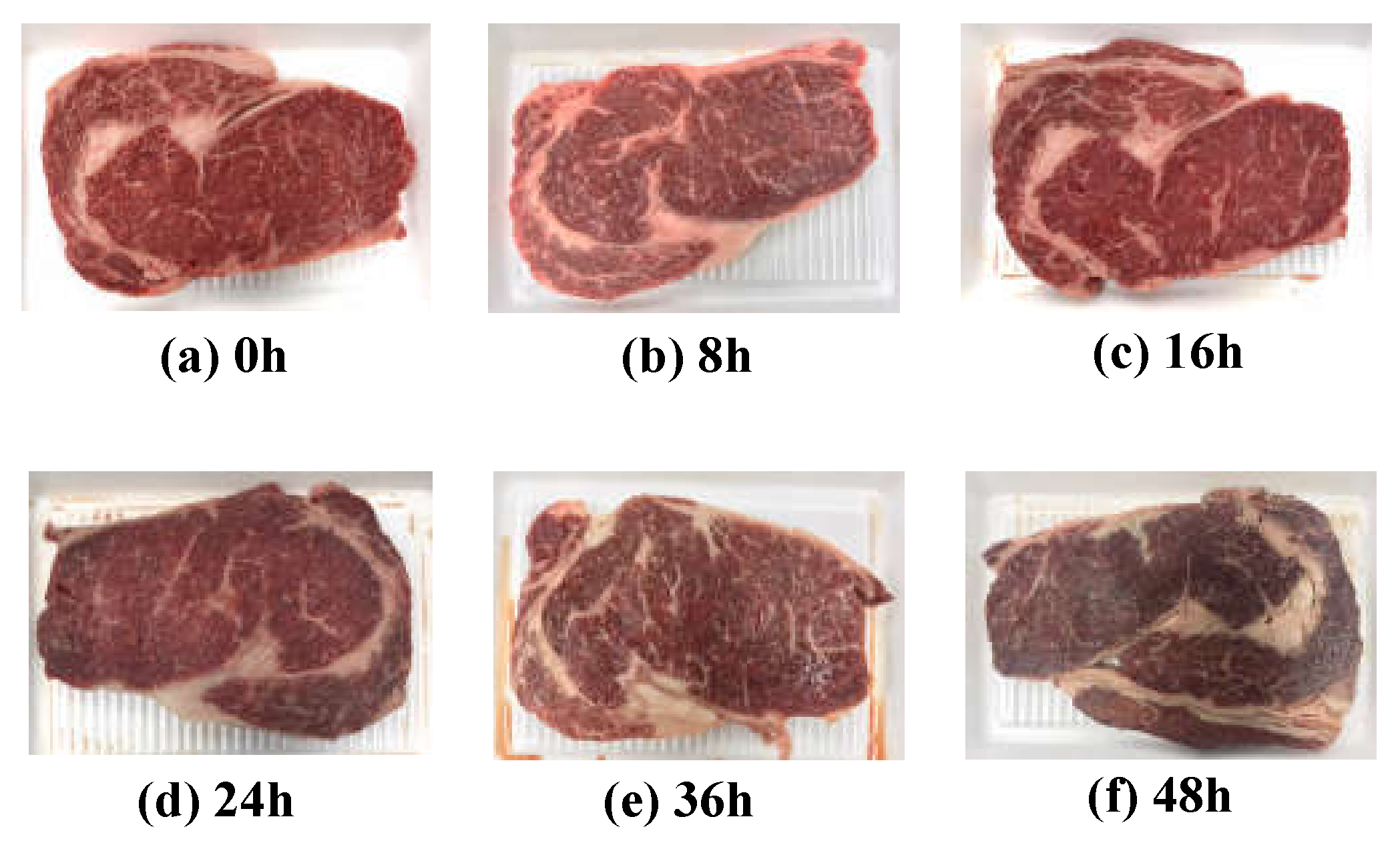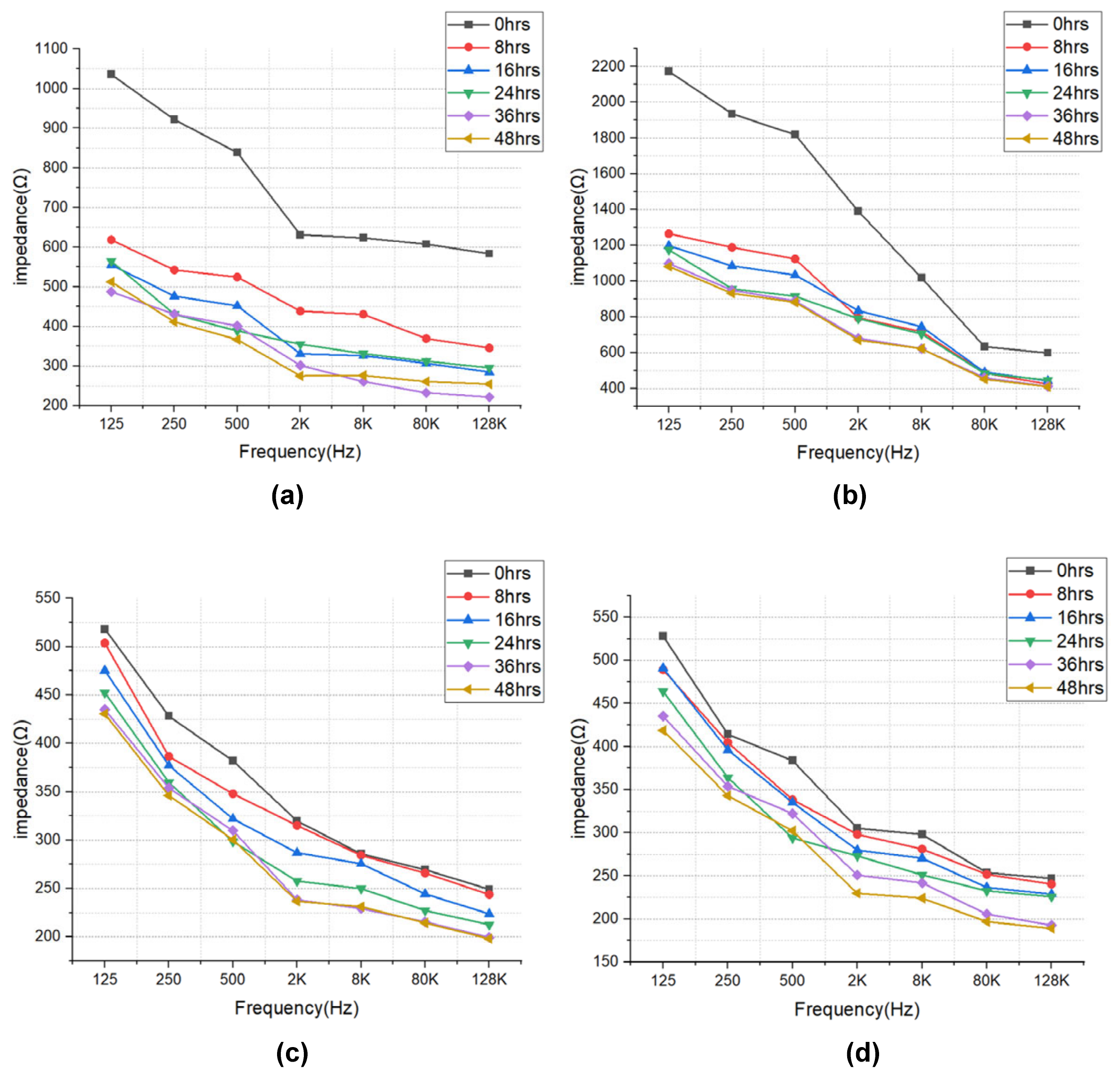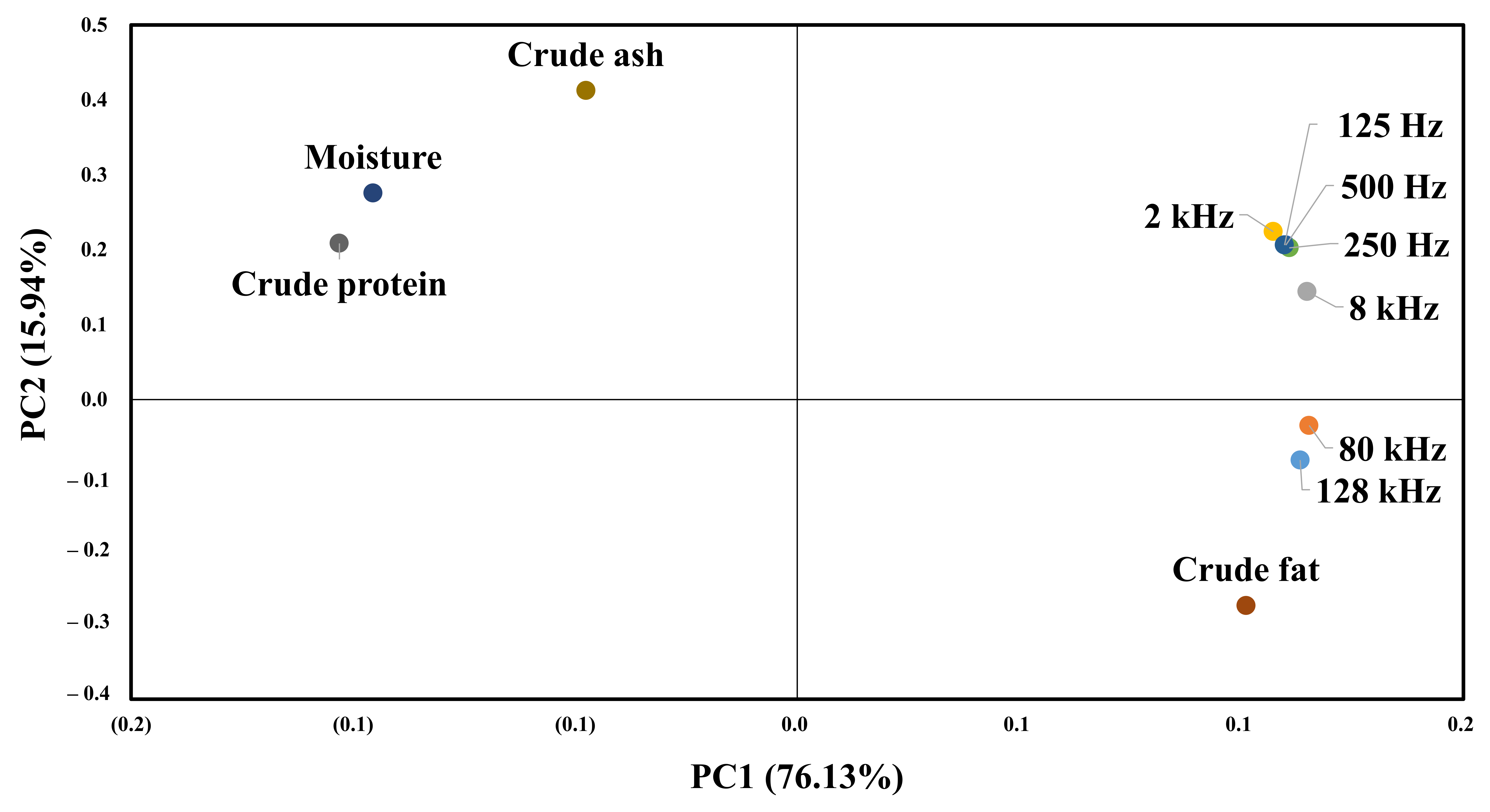Utilization of Electrical Impedance Spectroscopy and Image Classification for Non-Invasive Early Assessment of Meat Freshness
Abstract
:1. Introduction
2. Materials and Methods
2.1. Sample Preparation
2.2. EIS Measurement
2.3. APC Measurement
2.4. TBARS Measurement
2.5. Proximate Composition Measurement
2.6. Statistical Analysis
3. Results and Discussion
3.1. EIS Results
3.2. APC and TBARS Results
3.3. Correlation Between EIS and Microbiological Detection
3.4. Proximate Composition Results
3.5. Correlation between EIS and Composition Analysis
4. Image Classification with EIS Results
5. Conclusions
Author Contributions
Funding
Institutional Review Board Statement
Informed Consent Statement
Data Availability Statement
Conflicts of Interest
References
- Zhang, Y.; Mao, Y.; Li, K.; Dong, P.; Liang, R.; Luo, X. Models of pseudomonas growth kinetics and shelf life in chilled longis-simus dorsi muscles of beef. Asian-Aust. J. Anim. Sci. 2011, 24, 713–722. [Google Scholar]
- Domínguez, R.; Pateiro, M.; Gagaoua, M.; Barba, F.J.; Zhang, W.; Lorenzo, J.M. A comprehensive review on lipid oxidation in meat and meat products. Antioxidants 2019, 8, 429. [Google Scholar] [CrossRef] [PubMed] [Green Version]
- Koutsoumanis, K.; Stamatiou, A.; Skandamis, P.; Nychas, G.-J.E. Development of a microbial model for the combined effect of temperature and pH on spoilage of ground meat, and validation of the model under dynamic temperature conditions. Appl. Environ. Microbiol. 2006, 72, 124–134. [Google Scholar] [CrossRef] [PubMed] [Green Version]
- Pearson, D. Assessment of meat freshness in quality control employing chemical techniques: A review. J. Sci. Food Agric. 1968, 19, 357–363. [Google Scholar] [CrossRef]
- Strange, E.D.; Benedict, R.C.; Smith, J.L.; Swift, C.E. Evaluation of rapid tests for monitoring alterations in meat quality during storage. J. Food Prot. 1977, 40, 843–847. [Google Scholar] [CrossRef]
- Min, J.S.; Lee, S.O.; Jang, A.; Jo, C.; Park, C.S.; Lee, M. Relationship between the concentration of biogenic amines and vola-tile basic nitrogen in fresh beef, pork, and chicken meat. Asian Aust. J. Anim. Sci. 2007, 20, 1278–1284. [Google Scholar] [CrossRef]
- Byun, J.-S.; Min, J.S.; Kim, I.S.; Kim, J.-W.; Chung, M.-S.; Lee, M. Comparison of indicators of microbial quality of meat during aerobic cold storage. J. Food Prot. 2003, 66, 1733–1737. [Google Scholar] [CrossRef]
- Watanabe, A.; Daly, C.; Devine, C. The effects of the ultimate pH of meat on tenderness changes during ageing. Meat Sci. 1996, 42, 67–78. [Google Scholar] [CrossRef]
- Aksu, M.I.; Kaya, M.; Ockerman, H.W. Effect of modified atmosphere packaging and temperature on the shelf life of sliced pastirma produced from frozen/thawed meat. J. Muscle Foods 2005, 16, 192–206. [Google Scholar] [CrossRef]
- Raharjo, S.; Sofos, J.N.; Scmidt, G.R. Solid-phase acid extraction improves thiobarbituric acid method to determine lipid oxi-dation. J. Food Sci. 1993, 69, 921–924. [Google Scholar] [CrossRef]
- Fernández, J.; Pérez-Álvarez, J.A.; Fernández-López, J.A. Thiobarbituric acid test for monitoring lipid oxidation in meat. Food Chem. 1997, 59, 345–353. [Google Scholar] [CrossRef]
- Kim, J.H.; Yim, D.G. Assessment of the microbial level for livestock products in retail meat shops implementing HACCP sys-tem. Korean J. Food Sci. Anim. Resour. 2016, 36, 594–600. [Google Scholar] [CrossRef] [PubMed] [Green Version]
- Swe, M.M.; Eamsa-Ard, T.; Srikhirin, T.; Kerdcharoen, T. Monitoring the freshness level of beef using nanocomposite gas sen-sors in electronic nose. In Proceedings of the 2019 IEEE International Conference on Consumer Electronics—Asia (ICCE-Asia), Bangkok, Thailand, 12–14 June 2019. [Google Scholar]
- Chen, J.; Gu, J.; Zhang, R.; Mao, Y.; Tian, S. Freshness evaluation of three kinds of meats based on the electronic nose. Sensors 2019, 19, 605. [Google Scholar] [CrossRef] [PubMed] [Green Version]
- Wojnowski, W.; Majchrzak, T.; Dymerski, T.; Gebicki, J.; Namiesnik, J. Electromic noses: Powerful tools in meat quality as-sessment. Meat Sci. 2017, 131, 119–131. [Google Scholar] [CrossRef] [PubMed]
- Deisingh, A.K.; Stone, D.C.; Thompson, M. Applications of electronic noses and tongues in food analysis. Int. J. Food Sci. Technol. 2004, 39, 587–604. [Google Scholar] [CrossRef]
- Augstin, S.; Dijaya, R. Beef image classification using K-nearest neighbor algorithm for identification quality and freshness. J. Phys. Conf. Ser. 2019, 1179, 012184. [Google Scholar] [CrossRef] [Green Version]
- Sujiwo, J.; Kim, H.-J.; Song, S.-O.; Jang, A. Relationship between quality and freshness traits and torrymeter value of beef loin during cold storage. Meat Sci. 2019, 149, 120–125. [Google Scholar] [CrossRef]
- Damez, J.-L.; Clerjon, S.; Abouelkaram, S.; Lepetit, J. Beef meat electrical impedance spectroscopy and anisotropy sensing for non-invasive early assessment of meat ageing. J. Food Eng. 2008, 85, 116–122. [Google Scholar] [CrossRef]
- Guermazi, M.; Kanoun, O.; Derbel, N. Investigation of long time beef and veal meat behavior by bioimpedance spectroscopy for meat monitoring. IEEE Sens. J. 2014, 14, 3624–3630. [Google Scholar] [CrossRef]
- Afonso, J.; Guedes, C.; Santos, V.; Morais, R.; Silva, J.; Teixeira, A.; Silva, S.R. Utilization of bioelectrical impedance to predict intramuscular fat and physicochemical traits of the beef Longissimus Thoracis et Lumborum muscle. Foods 2020, 9, 836. [Google Scholar] [CrossRef]
- Byrne, C.; Troy, D.; Buckley, D. Postmortem changes in muscle electrical properties of bovine M. longissimus dorsi and their relationship to meat quality attributes and pH fall. Meat Sci. 2000, 54, 23–34. [Google Scholar] [CrossRef]
- Yang, Y.; Wang, Z.-Y.; Ding, Q.; Huang, L.; Wang, C.; Zhu, D.-Z. Moisture content prediction of porcine meat by bioelectrical impedance spectroscopy. Math. Comput. Model. 2013, 58, 819–825. [Google Scholar] [CrossRef]
- Grossi, M.; Riccò, B. Electrical impedance spectroscopy (EIS) for biological analysis and food characterization: A review. J. Sens. Sens. Syst. 2017, 6, 303–325. [Google Scholar] [CrossRef] [Green Version]
- Ben Ishai, P.; Talary, M.S.; Caduff, A.; Levy, E.; Feldman, Y. Electrode polarization in dielectric measurements: A review. Meas. Sci. Technol. 2013, 24, 102001–102021. [Google Scholar] [CrossRef]
- Fricke, H. A mathematical treatment of the electric conductivity and capacity of disperse systems I. the electric conductivity of a suspension of homogeneous spheroids. Phys. Rev. 1924, 24, 575–587. [Google Scholar] [CrossRef]
- Fricke, H. A mathematical treatment of the electric conductivity and capacity of disperse systems II. The capacity of a sus-pension of conducting spheroids surrounded by a nonconducting membrane for a current of low frequency. Phys. Rev. 1925, 26, 678–681. [Google Scholar] [CrossRef]
- Fricke, H.; Morse, S. The electric capacity of tumors of the breast. J. Cancer Res. 1926, 10, 340–376. [Google Scholar]
- Zhao, X.; Zhuang, H.; Yoon, S.-C.; Dong, Y.; Wang, W.; Zhao, W. Electrical impedance spectroscopy for quality assessment of meat and fish: A review on basic principles, measurement methods, and recent advances. J. Food Qual. 2017, 2017, 1–16. [Google Scholar] [CrossRef] [Green Version]
- Pliquett, U. Bioimpedance: A review for food processing. Food Eng. Rev. 2010, 2, 74–94. [Google Scholar] [CrossRef]
- Damez, J.-L.; Clerjon, S.; Abouelkaram, S.; Lepetit, J. Electrical impedance probing of the muscle food anisotropy for meat ageing control. Food Control 2008, 19, 931–939. [Google Scholar] [CrossRef]
- Cornish, B.H.; Thomas, B.J.; Ward, L.C. Improved prediction of extracellular and total body water using impedance loci gen-erated by multiple frequency bioelectrical impedance analysis. Phys. Med. Biol. 1993, 38, 337–346. [Google Scholar] [CrossRef] [PubMed]
- Damez, J.-L.; Clerjon, S.; Abouelkaram, S.; Lepetit, J. Dielectric behavior of beef meat in the 1–1500 kHz range: Simulation with the Fricke/Cole–Cole model. Meat Sci. 2007, 77, 512–519. [Google Scholar] [CrossRef] [PubMed]
- Schwan, H.P. Electrical properties of tissue and cell suspensions. Adv. Biol. Med. Phys. 1957, 5, 147–209. [Google Scholar] [PubMed]
- Ultra-Low-Power, Single-Channel Integrated Biopotential (ECG, R-to-R, and Pace Detection) and Bioimpedance (BioZ) AFE, MAX30001 Datasheet. 2019. Available online: https://datasheets.maximintegrated.com/en/ds/MAX30001.pdf (accessed on 4 December 2020).
- Guermazi, M.; Fendri, A.; Kanoun, O.; Derbel, N. Potential of impedance spectroscopy for real-time assessing of food quality. IEEE Instrum. Meas. Mag. 2018, 21, 44–48. [Google Scholar] [CrossRef]
- Guermazi, M.; Kanoun, O.; Derbel, N. Reduction of anisotropy influence and contacting effects in in-vitro bioimpedance measurements. J. Phys. Conf. Ser. 2013, 434, 012058. [Google Scholar] [CrossRef] [Green Version]
- Kim, H.-J.; Jeon, J.; Nam, K.-C.; Shim, K.-S.; Jung, J.-H.; Kim, K.S.; Choi, Y.; Kim, S.-H.; Jang, A. Comparison of the quality characteristics of chicken breast meat from conventional and animal welfare farms under refrigerated storage. Poult. Sci. 2020, 99, 1788–1796. [Google Scholar] [CrossRef]
- Horwitz, W.; Latimer, G.W. Official Methods of Analysis of AOAC International, 18th ed.; AOAC International: Gaithersburg, Maryland, 2005; pp. 1–24. [Google Scholar]
- Jung, E.-Y.; Hwang, Y.-H.; Joo, S.-T. The relationship between chemical compositions, meat quality, and palatability of the 10 primal cuts from Hanwoo steer. Food Sci. Anim. Resour. 2016, 36, 145–151. [Google Scholar] [CrossRef] [Green Version]
- Hur, S.J.; Jin, S.K.; Park, J.H.; Jung, S.W.; Lyu, H.J. Effect of modified atmosphere packaging and vacuum packaging on qual-ity characteristics of low grade beef during cold storage. Asian Aust. J. Anim. Sci. 2013, 26, 1781–1789. [Google Scholar] [CrossRef] [Green Version]
- Kim, H.J.; Jang, A. Correlations between the levels of the bioactive compounds and quality traits in beef loin and round during cold storage. Food Control 2021, 120, 107491. [Google Scholar] [CrossRef]
- Moon, J.H.; Sung, M.; Kim, J.H.; Kim, B.S.; Kim, Y. Quality factors of freshness and palatability of Hanwoo from their physicochemical and sensorial properties. Korean J. Food Sci. Anim. Resour. 2013, 33, 796–805. [Google Scholar] [CrossRef]
- Prommachart, R.; Belem, T.S.; Uriyapongson, S.; Rayas-Duarte, P.; Uriyapongson, J.; Ramanathan, R. The effect of black rice water extract on surface color, lipid oxidation, microbial growth, and antioxidant activity of beef patties during chilled storage. Meat Sci. 2020, 164, 108091. [Google Scholar] [CrossRef] [PubMed]
- Campo, M.; Nute, G.; Hughes, S.; Enser, M.; Wood, J.; Richardson, R. Flavour perception of oxidation in beef. Meat Sci. 2006, 72, 303–311. [Google Scholar] [CrossRef] [PubMed]
- Kim, I.S.; Lee, S.O.; Lee, M.; Lee, J.M.; Kim, J.H.; Kim, Y.G. Physicochemical, microbiological, and sensory characteristics of chilled chuck rolls of Han-Woo and imported beef. Korean J. Anim. Sci. 2000, 42, 109–116. [Google Scholar]
- Koh, K.; Chung, K.-Y.; Kim, H.-S.; Kang, S.-J.; Choi, C.B.; Jo, C.; Choe, J. Determination of point of sale and consumption for hanwoo beef based on quality grade and aging time. Food Sci. Anim. Resour. 2019, 39, 139–150. [Google Scholar] [CrossRef]
- Yim, D.G.; Jo, C.; Kim, H.J.; Cha, J.S.; Kim, H.C.; Nam, K.C. Combined effect of Irradiation and ageing condition on physico-chemical and microbial quality of Hanwoo eye of round. Korean J. Food Sci. Anim. Resour. 2015, 35, 406–412. [Google Scholar] [CrossRef] [Green Version]
- Cho, S.-H.; Seong, P.; Kang, G.; Choi, S.; Chang, S.; Kang, S.M.; Park, K.M.; Kim, Y.; Hong, S.; Park, B.Y. Effect of age on chemical composition and meat quality for loin and top round of Hanwoo cow beef. Food Sci. Anim. Resour. 2012, 32, 810–819. [Google Scholar] [CrossRef] [Green Version]
- Lee, K.T.; Yoon, C.-S. Quality changes and shelf life of imported vacuum-packaged beef chuck during storage at 0 °C. Meat Sci. 2001, 59, 71–77. [Google Scholar] [CrossRef]
- Yun, Y.; Lee, B.; Yeongkwon, Y.; Kang, S.-J.; Oh, E.; Choi, Y.M.; Boin, L.; Kimun, K.; Sejoo, K.; Eunmi, O. Comparison of beef palatability characteristics between longissimus thoracis and vastus lateralis muscles from different grades during postmortem aging. Food Sci. Anim. Resour. 2020, 40, 34–43. [Google Scholar] [CrossRef]
- Kulkarni, S.; Kelkar, V. Classification of multispectral satellite images using ensemble techniques of bagging, boosting and adaboost. In Proceedings of the 2014 International Conference on Circuits, Systems, Communication and Information Technology Applications (CSCITA), Mumbai, India, 4–5 April 2014; pp. 253–258. [Google Scholar]
- Trientin, D.; Hidayat, B.; Darana, S. Beef freshness classification by using color analysis, multi-wavelet transformation, and artificial neural network. In Proceedings of the 2015 International Conference on Automation, Cognitive Science, Optics, Micro Electro-Mechanical Sys-tem, and Information Technology (ICACOMIT), Bandung, Indonesia, 29–30 October 2015; pp. 181–185. [Google Scholar]










| Meat | Freshness | Frequency (Hz) | ||||||
|---|---|---|---|---|---|---|---|---|
| 128 K | 80 K | 8 K | 2 K | 500 | 250 | 125 | ||
| Beef Loin (Quality Grade 1+) | APC | −0.784 ** | −0.788 ** | −0.796 ** | −0.778 ** | −0.675 ** | −0.659 ** | −0.629 ** |
| TBARS | −0.850 ** | −0.852 ** | −0.837 ** | −0.804 ** | −0.726 ** | −0.715 ** | −0.669 ** | |
| Beef Loin (Quality Grade 1) | APC | −0.350 | −0.327 | −0.383 * | −0.409 * | −0.483 ** | −0.485 ** | −0.466 ** |
| TBARS | −0.481 ** | −0.425 * | −0.490 ** | −0.509 ** | −0.610 ** | −0.617 ** | −0.605 ** | |
| Beef Round (Quality Grade 1+) | APC | −0.408 * | −0.416 * | −0.387 * | −0.412 * | −0.066 | −0.022 | −0.001 |
| TBARS | −0.445 * | −0.468 ** | −0.412 * | −0.464 ** | −0.146 | −0.073 | −0.055 | |
| Beef Round (Quality Grade 1) | APC | −0.736 ** | −0.702 ** | −0.522 ** | −0.476 ** | −0.303 | −0.376 * | −0.422 * |
| TBARS | −0.648 ** | −0.628 ** | −0.539 ** | −0.454 * | −0.343 | −0.334 | −0.422 * | |
| Proximate Composition (%) | Beef Loin | Beef Round | SEM | ||
|---|---|---|---|---|---|
| Grade 1+ | Grade 1 | Grade 1+ | Grade 1 | ||
| Moisture | 62.62 c | 64.22 b | 70.72 a | 70.51 a | 0.352 |
| Crude Fat | 17.59 a | 15.02 b | 6.43 c | 6.04 c | 0.313 |
| Crude Protein | 18.87 b | 19.67 b | 21.66 a | 22.28 a | 0.314 |
| Crude Ash | 0.91 a | 1.08 a | 1.19 a | 1.18 a | 0.078 |
| Proximate Composition | Frequency (Hz) | ||||||
|---|---|---|---|---|---|---|---|
| 128 K | 80 K | 8 K | 2 K | 500 | 250 | 125 | |
| Moisture | −0.826 ** | −783 ** | −0.635 ** | −0.483 * | −0.562 ** | −0.571 ** | −0.556 * |
| Crude Fat | 0.861 ** | 0.832 ** | 0.680 ** | 0.539 * | 0.604 ** | 0.613 ** | 0.601 ** |
| Crude Protein | −0.845 ** | −0.857 ** | −0.724 ** | −0.626 ** | −0.652 ** | −0.665 ** | −0.658 ** |
| Crude Ash | −0.432 | −0.387 | −0.227 | −0.155 | −0.147 | −0.146 | −0.145 |
| 5 Class | 4 Class | 3 Class | |
|---|---|---|---|
| Accuracy (%) | |||
| Image | 20 | 43.66 | 56.66 |
| Image + EIS | 55.0 | 61.66 | 85.0 |
| Image | EIS | Image + EIS | ||
|---|---|---|---|---|
| RSD | APC | 2.012 | 1.555 | 1.197 |
| TBARS | 1.802 | 0.890 | 0.678 |
| Crude Fat | Crude Protein | Crude Ash | Moisture | |
|---|---|---|---|---|
| RSD | 4.571 | 2.409 | 11.574 | 0.872 |
Publisher’s Note: MDPI stays neutral with regard to jurisdictional claims in published maps and institutional affiliations. |
© 2021 by the authors. Licensee MDPI, Basel, Switzerland. This article is an open access article distributed under the terms and conditions of the Creative Commons Attribution (CC BY) license (http://creativecommons.org/licenses/by/4.0/).
Share and Cite
Huh, S.; Kim, H.-J.; Lee, S.; Cho, J.; Jang, A.; Bae, J. Utilization of Electrical Impedance Spectroscopy and Image Classification for Non-Invasive Early Assessment of Meat Freshness. Sensors 2021, 21, 1001. https://doi.org/10.3390/s21031001
Huh S, Kim H-J, Lee S, Cho J, Jang A, Bae J. Utilization of Electrical Impedance Spectroscopy and Image Classification for Non-Invasive Early Assessment of Meat Freshness. Sensors. 2021; 21(3):1001. https://doi.org/10.3390/s21031001
Chicago/Turabian StyleHuh, Sooin, Hye-Jin Kim, Seungah Lee, Jinwoo Cho, Aera Jang, and Joonsung Bae. 2021. "Utilization of Electrical Impedance Spectroscopy and Image Classification for Non-Invasive Early Assessment of Meat Freshness" Sensors 21, no. 3: 1001. https://doi.org/10.3390/s21031001







